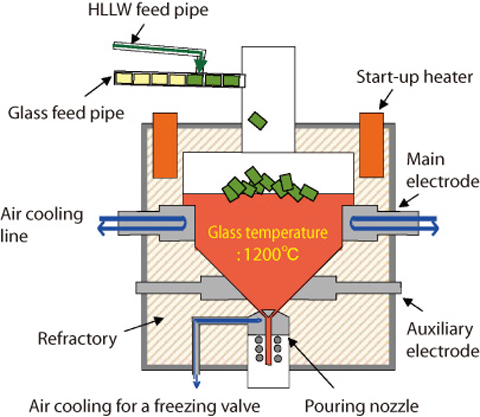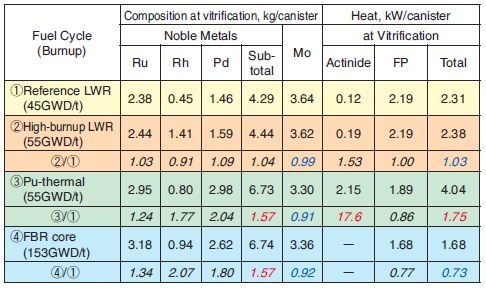
Fig.8-1 Configuration of the TVF melter
Table 8-1 Changes of compositions of noble metals and molybdenum,
and heat generation of HLWs generated from future fuel cycles

High level radioactive liquid waste (HLLW) generated from the Tokai reprocessing plant has been converted to stable glass in the TVF (Fig.8-1). The hot operation started in 1995. A total of 218 vitrified waste canisters were produced by the end of March, 2006. Aiming to prevent accumulation of noble metals at the bottom of the melter which affects heating efficiency etc., a low-temperature operation mode has been developed and applied to the operation.
It is recognized that vitrification is one of the key technologies for establishing future fuel cycles. Thus, continuous effort for further improvement and increased reliability is strongly required. We are now developing improvements focusing on the melter; a new bottom structure radically reducing accumulation of noble metals, extending the melter' s life-time, and a simulation technique considering coupled physical phenomena.
High volume reduction technology is also being developed to decrease the number of HLW canisters by increasing the waste loading ratio. The most important research issues concern generation of a soluble molybdenum salt in the HLW. Basic experiments and melter tests for cold vitrification are now being carried out.
Applicability and flexibility of the current HLW vitrification technology in the LWR fuel cycle to the future fuel cycles were reviewed by examining characteristics of the HLWs; compositions of noble metals and molybdenum, and heat generation influencing storage and/or disposal facility designs of HLW. The present PUREX process was considered in both high-burnup LWR and Pu-thermal fuel cycles. For the FBR cycle, a flow sheet of the NEXT system which was studied as an advanced reprocessing system in the feasibility study on commercialized FBR cycle systems (FS- I) (detail description is in Chap.1, Sec.16).
Table 8-1 indicates the evaluation results. Increase of burnup in LWR uranium fuel has negligible effect on fractions of noble metals and molybdenum and on heat generation. The close to 60% increase of noble metal content in Pu-thermal and FBR cycles suggests importance of development of measures preventing noble metal accumulation in the melter. Heat of HLW generated from the Pu-thermal cycle is increased remarkably due to higher heat generation by actinide. Such results make application of an MA recovery process in the NEXT system desirable. Since change of molybdenum concentrations in each cycle is small, this high volume reduction technology is expected to be applicable for these future cycles.
<Previous: 8 Nuclear Fuel Cycle Technological Development | Next: 8-3 >